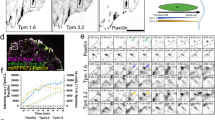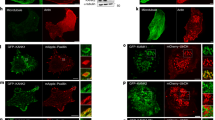Abstract
Networks of actin filaments, controlled by the Arp2/3 complex, drive membrane protrusion during cell migration. How integrins signal to the Arp2/3 complex is not well understood. Here, we show that focal adhesion kinase (FAK) and the Arp2/3 complex associate and colocalize at transient structures formed early after adhesion. Nascent lamellipodia, which originate at these structures, do not form in FAK-deficient cells, or in cells in which FAK mutants cannot be autophosphorylated after integrin engagement. The FERM domain of FAK binds directly to Arp3 and can enhance Arp2/3-dependent actin polymerization. Critically, Arp2/3 is not bound when FAK is phosphorylated on Tyr 397. Interfering peptides and FERM-domain point mutants show that FAK binding to Arp2/3 controls protrusive lamellipodia formation and cell spreading. This establishes a new function for the FAK FERM domain in forming a phosphorylation-regulated complex with Arp2/3, linking integrin signalling directly with the actin polymerization machinery.
This is a preview of subscription content, access via your institution
Access options
Subscribe to this journal
Receive 12 print issues and online access
$209.00 per year
only $17.42 per issue
Buy this article
- Purchase on Springer Link
- Instant access to full article PDF
Prices may be subject to local taxes which are calculated during checkout








Similar content being viewed by others
References
Welch, M. D., Mallavarapu, A., Rosenblatt, J. & Mitchison, T. J. Actin dynamics in vivo. Curr. Opin. Cell Biol. 9, 54–61 (1997).
Svitkina, T. M. & Borisy, G. G. Arp2/3 complex and actin depolymerizing factor/cofilin in dendritic organization and treadmilling of actin filament array in lamellipodia. J. Cell Biol. 145, 1009–1026 (1999).
Mullins, R. D., Heuser, J. A. & Pollard, T. D. The interaction of Arp2/3 complex with actin: nucleation, high affinity pointed end capping, and formation of branching networks of filaments. Proc. Natl Acad. Sci. USA 95, 6181–6186 (1998).
Machesky, L. M. & Insall, R. H. Scar1 and the related Wiskott-Aldrich syndrome protein, WASP, regulate the actin cytoskeleton through the Arp2/3 complex. Curr. Biol. 8, 1347–1356 (1998).
Miki, H., Suetsugu, S. & Takenawa, T. WAVE, a novel WASP-family protein involved in actin reorganization induced by Rac. EMBO J. 17, 6932–6941 (1998).
Robinson, R. C. et al. Crystal structure of Arp2/3 complex. Science 294, 1679–1684 (2001).
Rohatgi, R. et al. The interaction between N-WASP and the Arp2/3 complex links Cdc42-dependent signals to actin assembly. Cell 97, 221–231 (1999).
Butler, B., Gao, C., Mersich, A. T. & Blystone, S. D. Purified integrin adhesion complexes exhibit actin-polymerization activity. Curr. Biol. 16, 242–251 (2006).
DeMali, K. A., Barlow, C. A. & Burridge, K. Recruitment of the Arp2/3 complex to vinculin: coupling membrane protrusion to matrix adhesion. J. Cell Biol. 159, 881–891 (2002).
Coll, J. L. et al. Targeted disruption of vinculin genes in F9 and embryonic stem cells changes cell morphology, adhesion, and locomotion. Proc. Natl Acad. Sci. USA 92, 9161–9165 (1995).
Xu, W., Baribault, H. & Adamson, E. D. Vinculin knockout results in heart and brain defects during embryonic development. Development 125, 327–337 (1998).
Ilic, D. et al. Reduced cell motility and enhanced focal adhesion contact formation in cells from FAK-deficient mice. Nature 377, 539–544 (1995).
Richardson, A., Malik, R. K., Hildebrand, J. D. & Parsons, J. T. Inhibition of cell spreading by expression of the C-terminal domain of focal adhesion kinase (FAK) is rescued by coexpression of Src or catalytically inactive FAK: a role for paxillin tyrosine phosphorylation. Mol. Cell Biol. 17, 6906–6914 (1997).
Ren, X. D. et al. Focal adhesion kinase suppresses Rho activity to promote focal adhesion turnover. J. Cell Sci. 113, 3673–3678 (2000).
Westhoff, M. A., Serrels, B., Fincham, V. J., Frame, M. C. & Carragher, N. O. SRC-mediated phosphorylation of focal adhesion kinase couples actin and adhesion dynamics to survival signaling. Mol. Cell Biol. 24, 8113–8133 (2004).
de Hoog, C. L., Foster, L. J. & Mann, M. RNA and RNA binding proteins participate in early stages of cell spreading through spreading initiation centers. Cell 117, 649–662 (2004).
Wu, X., Suetsugu, S., Cooper, L. A., Takenawa, T. & Guan, J. L. Focal adhesion kinase regulation of N-WASP subcellular localization and function. J. Biol. Chem. 279, 9565–9576 (2004).
Pollard, T. D. & Beltzner, C. C. Structure and function of the Arp2/3 complex. Curr. Opin. Struct. Biol. 12, 768–774 (2002).
Millard, T. H., Sharp, S. J. & Machesky, L. M. Signalling to actin assembly via the WASP (Wiskott-Aldrich syndrome protein)-family proteins and the Arp2/3 complex. Biochem. J. 380, 1–17 (2004).
Lietha, D. et al. Structural basis for the autoinhibition of focal adhesion kinase. Cell 129, 1177–1187 (2007).
Hotulainen, P. & Lappalainen, P. Stress fibers are generated by two distinct actin assembly mechanisms in motile cells. J. Cell Biol. 173, 383–394 (2006).
Guo, F., Debidda, M., Yang, L., Williams, D. A. & Zheng, Y. Genetic deletion of Rac1 GTPase reveals its critical role in actin stress fiber formation and focal adhesion complex assembly. J. Biol. Chem. 281, 18652–18659 (2006).
Chen, R. et al. Regulation of the PH-domain-containing tyrosine kinase Etk by focal adhesion kinase through the FERM domain. Nature Cell Biol. 3, 439–444 (2001).
Dunty, J. M. et al. FERM domain interaction promotes FAK signaling. Mol. Cell Biol. 24, 5353–5368 (2004).
Jacamo, R. O. & Rozengurt, E. A truncated FAK lacking the FERM domain displays high catalytic activity but retains responsiveness to adhesion-mediated signals. Biochem. Biophys. Res. Commun. 334, 1299–1304 (2005).
Cohen, L. A. & Guan, J. L. Residues within the first subdomain of the FERM-like domain in focal adhesion kinase are important in its regulation. J. Biol. Chem. 280, 8197–8207 (2005).
Avizienyte, E. et al. Src-induced de-regulation of E-cadherin in colon cancer cells requires integrin signalling. Nature Cell Biol. 4, 632–638 (2002).
Yarrow, J. C., Lechler, T., Li, R. & Mitchison, T. J. Rapid de-localization of actin leading edge components with BDM treatment. BMC Cell Biol. 4, 5 (2003).
Acknowledgements
This work was supported by Cancer Research UK Program Grant and the Medical Research Council (G.E.J.). We would like to thank M. Kirschner for anti-WASP antibody and D. Ilic for FAK-deficient mouse cells.
Author information
Authors and Affiliations
Contributions
B.S. and A.S. performed the experimental work. M.H. performed FRAP analysis. V.G.B., G.W.M., G.E.J. and M.C.F. provided extensive scientific input. C.H.G. provided structural biology support. M.C.F. carried out the scientific writing.
Corresponding author
Ethics declarations
Competing interests
The authors declare no competing financial interests.
Supplementary information
Supplementary Information
Supplementary Figures 1, 2, 3, 4, 5 and 6 (PDF 739 kb)
Rights and permissions
About this article
Cite this article
Serrels, B., Serrels, A., Brunton, V. et al. Focal adhesion kinase controls actin assembly via a FERM-mediated interaction with the Arp2/3 complex. Nat Cell Biol 9, 1046–1056 (2007). https://doi.org/10.1038/ncb1626
Received:
Accepted:
Published:
Issue Date:
DOI: https://doi.org/10.1038/ncb1626
This article is cited by
-
Polarized focal adhesion kinase activity within a focal adhesion during cell migration
Nature Chemical Biology (2023)
-
Targeting FAK in anticancer combination therapies
Nature Reviews Cancer (2021)
-
Wound Healing by Keratinocytes: A Cytoskeletal Perspective
Journal of the Indian Institute of Science (2021)
-
Focal adhesion kinase (FAK) activation by estrogens involves GPER in triple-negative breast cancer cells
Journal of Experimental & Clinical Cancer Research (2019)
-
Large-scale curvature sensing by directional actin flow drives cellular migration mode switching
Nature Physics (2019)



